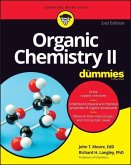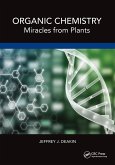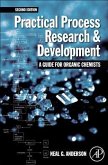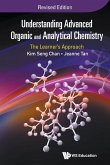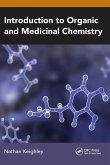Charles S. Gibson
Essential Principles of Organic Chemistry
Charles S. Gibson
Essential Principles of Organic Chemistry
- Broschiertes Buch
- Merkliste
- Auf die Merkliste
- Bewerten Bewerten
- Teilen
- Produkt teilen
- Produkterinnerung
- Produkterinnerung
Originally published in 1936, this textbook covers a wide variety of topics in the area of general chemistry and physics.
Andere Kunden interessierten sich auch für
![Organic Chemistry II for Dummies Organic Chemistry II for Dummies]() John T. MooreOrganic Chemistry II for Dummies26,99 €
John T. MooreOrganic Chemistry II for Dummies26,99 €![Organic Chemistry Organic Chemistry]() Jeffrey John DeakinOrganic Chemistry87,99 €
Jeffrey John DeakinOrganic Chemistry87,99 €![Organic Chemistry Digital Update (International Edition) Organic Chemistry Digital Update (International Edition)]() K. Peter C. VollhardtOrganic Chemistry Digital Update (International Edition)89,99 €
K. Peter C. VollhardtOrganic Chemistry Digital Update (International Edition)89,99 €![Practical Process Research and Development - A Guide for Organic Chemists Practical Process Research and Development - A Guide for Organic Chemists]() Neal G. AndersonPractical Process Research and Development - A Guide for Organic Chemists139,99 €
Neal G. AndersonPractical Process Research and Development - A Guide for Organic Chemists139,99 €![UNDERSTAND ADV ORGANIC (REV ED) UNDERSTAND ADV ORGANIC (REV ED)]() Kim Seng Chan (Singapore Eunoia Junior College)UNDERSTAND ADV ORGANIC (REV ED)82,99 €
Kim Seng Chan (Singapore Eunoia Junior College)UNDERSTAND ADV ORGANIC (REV ED)82,99 €![Introduction to Organic and Medicinal Chemistry Introduction to Organic and Medicinal Chemistry]() Nathan KeighleyIntroduction to Organic and Medicinal Chemistry66,99 €
Nathan KeighleyIntroduction to Organic and Medicinal Chemistry66,99 €![Synthetic Organic Chemistry and the Nobel Prize Volume 1 Synthetic Organic Chemistry and the Nobel Prize Volume 1]() John G. D'Angelo (Alfred University, NY, USA)Synthetic Organic Chemistry and the Nobel Prize Volume 172,99 €
John G. D'Angelo (Alfred University, NY, USA)Synthetic Organic Chemistry and the Nobel Prize Volume 172,99 €-
-
Originally published in 1936, this textbook covers a wide variety of topics in the area of general chemistry and physics.
Hinweis: Dieser Artikel kann nur an eine deutsche Lieferadresse ausgeliefert werden.
Hinweis: Dieser Artikel kann nur an eine deutsche Lieferadresse ausgeliefert werden.
Produktdetails
- Produktdetails
- Verlag: Cambridge University Press
- Seitenzahl: 558
- Erscheinungstermin: 4. Januar 2016
- Englisch
- Abmessung: 216mm x 140mm x 33mm
- Gewicht: 736g
- ISBN-13: 9781316603864
- ISBN-10: 1316603865
- Artikelnr.: 44943112
- Herstellerkennzeichnung
- Libri GmbH
- Europaallee 1
- 36244 Bad Hersfeld
- gpsr@libri.de
- Verlag: Cambridge University Press
- Seitenzahl: 558
- Erscheinungstermin: 4. Januar 2016
- Englisch
- Abmessung: 216mm x 140mm x 33mm
- Gewicht: 736g
- ISBN-13: 9781316603864
- ISBN-10: 1316603865
- Artikelnr.: 44943112
- Herstellerkennzeichnung
- Libri GmbH
- Europaallee 1
- 36244 Bad Hersfeld
- gpsr@libri.de
Preface
Introductory. Quadrivalency of carbon and deduction of types of carbon compounds
qualitative and quantitative analysis of organic compounds
determination of empirical and molecular formulae. The 'architecture' or constitution of the molecule
1. Aliphatic hydrocarbons: paraffins, ethylenes (olefines), cycloparaffins, acetylenes and other unsaturated aliphatic hydrocarbons
2. Aromatic hydrocarbons: benzene and its homologues. Aromatic derivatives of unsaturated hydrocarbons. Diphenyl, diphenylmethane, triphenylmethane, naphthalene, anthracene and phenanthrene
3. Monohydroxy-derivatives of hydrocarbons: alcohols and certain derivatives
4. Hydroxy-derivatives of cyclic hydrocarbons: phenols and certain derivatives
5. Ethers
6. Aldehydes and ketones and certain derivatives
7. Simple monobasic acids: acid chlorides, acid anhydrides, amides and esters
8. Homologues of acetic acid. Monobasic unsaturated acids and some derivatives
9. Aromatic acids and some derivatives
10. Organic bases: aliphatic amines and some derivatives
aromatic amines and some derivatives
heterocyclic bases and some derivatives
11. Amino acids: x-amino acids and their derivatives
peptides. Aromatic amino acids. Indigo
12. Stereoisomerism and optical activity
13. Glycols (dihydric alcohols) and some derivatives
malonic and acetoacetic acid and some derivatives
14. Glycerol and some derivatives. The erythritols and tartaric acids: hemihedrism and enantiomorphism
resolution of racemic acid
15. n-pentitols and pentoses. n-hexitols and hexoses or monosaccharides: glycosides, disaccharides and polysaccharides. Estimation of reducing sugars. Fermentation of hexoses
16. Derivatives of carbonic acid. Urea and certain derivatives
ureides
guanidine and certain derivatives
purines
17. Organo-metallic compounds: syntheses by means of zinc alkyls and magnesium alkyl and aryl halides
Appendix. Isolation and purification of organic compounds
identification and determination of physical constants of organic compounds
typical apparatus used in the preparation and isolation of organic compounds
Table of symbols, atomic numbers and atomic weights
References
Index.
Introductory. Quadrivalency of carbon and deduction of types of carbon compounds
qualitative and quantitative analysis of organic compounds
determination of empirical and molecular formulae. The 'architecture' or constitution of the molecule
1. Aliphatic hydrocarbons: paraffins, ethylenes (olefines), cycloparaffins, acetylenes and other unsaturated aliphatic hydrocarbons
2. Aromatic hydrocarbons: benzene and its homologues. Aromatic derivatives of unsaturated hydrocarbons. Diphenyl, diphenylmethane, triphenylmethane, naphthalene, anthracene and phenanthrene
3. Monohydroxy-derivatives of hydrocarbons: alcohols and certain derivatives
4. Hydroxy-derivatives of cyclic hydrocarbons: phenols and certain derivatives
5. Ethers
6. Aldehydes and ketones and certain derivatives
7. Simple monobasic acids: acid chlorides, acid anhydrides, amides and esters
8. Homologues of acetic acid. Monobasic unsaturated acids and some derivatives
9. Aromatic acids and some derivatives
10. Organic bases: aliphatic amines and some derivatives
aromatic amines and some derivatives
heterocyclic bases and some derivatives
11. Amino acids: x-amino acids and their derivatives
peptides. Aromatic amino acids. Indigo
12. Stereoisomerism and optical activity
13. Glycols (dihydric alcohols) and some derivatives
malonic and acetoacetic acid and some derivatives
14. Glycerol and some derivatives. The erythritols and tartaric acids: hemihedrism and enantiomorphism
resolution of racemic acid
15. n-pentitols and pentoses. n-hexitols and hexoses or monosaccharides: glycosides, disaccharides and polysaccharides. Estimation of reducing sugars. Fermentation of hexoses
16. Derivatives of carbonic acid. Urea and certain derivatives
ureides
guanidine and certain derivatives
purines
17. Organo-metallic compounds: syntheses by means of zinc alkyls and magnesium alkyl and aryl halides
Appendix. Isolation and purification of organic compounds
identification and determination of physical constants of organic compounds
typical apparatus used in the preparation and isolation of organic compounds
Table of symbols, atomic numbers and atomic weights
References
Index.
Preface
Introductory. Quadrivalency of carbon and deduction of types of carbon compounds
qualitative and quantitative analysis of organic compounds
determination of empirical and molecular formulae. The 'architecture' or constitution of the molecule
1. Aliphatic hydrocarbons: paraffins, ethylenes (olefines), cycloparaffins, acetylenes and other unsaturated aliphatic hydrocarbons
2. Aromatic hydrocarbons: benzene and its homologues. Aromatic derivatives of unsaturated hydrocarbons. Diphenyl, diphenylmethane, triphenylmethane, naphthalene, anthracene and phenanthrene
3. Monohydroxy-derivatives of hydrocarbons: alcohols and certain derivatives
4. Hydroxy-derivatives of cyclic hydrocarbons: phenols and certain derivatives
5. Ethers
6. Aldehydes and ketones and certain derivatives
7. Simple monobasic acids: acid chlorides, acid anhydrides, amides and esters
8. Homologues of acetic acid. Monobasic unsaturated acids and some derivatives
9. Aromatic acids and some derivatives
10. Organic bases: aliphatic amines and some derivatives
aromatic amines and some derivatives
heterocyclic bases and some derivatives
11. Amino acids: x-amino acids and their derivatives
peptides. Aromatic amino acids. Indigo
12. Stereoisomerism and optical activity
13. Glycols (dihydric alcohols) and some derivatives
malonic and acetoacetic acid and some derivatives
14. Glycerol and some derivatives. The erythritols and tartaric acids: hemihedrism and enantiomorphism
resolution of racemic acid
15. n-pentitols and pentoses. n-hexitols and hexoses or monosaccharides: glycosides, disaccharides and polysaccharides. Estimation of reducing sugars. Fermentation of hexoses
16. Derivatives of carbonic acid. Urea and certain derivatives
ureides
guanidine and certain derivatives
purines
17. Organo-metallic compounds: syntheses by means of zinc alkyls and magnesium alkyl and aryl halides
Appendix. Isolation and purification of organic compounds
identification and determination of physical constants of organic compounds
typical apparatus used in the preparation and isolation of organic compounds
Table of symbols, atomic numbers and atomic weights
References
Index.
Introductory. Quadrivalency of carbon and deduction of types of carbon compounds
qualitative and quantitative analysis of organic compounds
determination of empirical and molecular formulae. The 'architecture' or constitution of the molecule
1. Aliphatic hydrocarbons: paraffins, ethylenes (olefines), cycloparaffins, acetylenes and other unsaturated aliphatic hydrocarbons
2. Aromatic hydrocarbons: benzene and its homologues. Aromatic derivatives of unsaturated hydrocarbons. Diphenyl, diphenylmethane, triphenylmethane, naphthalene, anthracene and phenanthrene
3. Monohydroxy-derivatives of hydrocarbons: alcohols and certain derivatives
4. Hydroxy-derivatives of cyclic hydrocarbons: phenols and certain derivatives
5. Ethers
6. Aldehydes and ketones and certain derivatives
7. Simple monobasic acids: acid chlorides, acid anhydrides, amides and esters
8. Homologues of acetic acid. Monobasic unsaturated acids and some derivatives
9. Aromatic acids and some derivatives
10. Organic bases: aliphatic amines and some derivatives
aromatic amines and some derivatives
heterocyclic bases and some derivatives
11. Amino acids: x-amino acids and their derivatives
peptides. Aromatic amino acids. Indigo
12. Stereoisomerism and optical activity
13. Glycols (dihydric alcohols) and some derivatives
malonic and acetoacetic acid and some derivatives
14. Glycerol and some derivatives. The erythritols and tartaric acids: hemihedrism and enantiomorphism
resolution of racemic acid
15. n-pentitols and pentoses. n-hexitols and hexoses or monosaccharides: glycosides, disaccharides and polysaccharides. Estimation of reducing sugars. Fermentation of hexoses
16. Derivatives of carbonic acid. Urea and certain derivatives
ureides
guanidine and certain derivatives
purines
17. Organo-metallic compounds: syntheses by means of zinc alkyls and magnesium alkyl and aryl halides
Appendix. Isolation and purification of organic compounds
identification and determination of physical constants of organic compounds
typical apparatus used in the preparation and isolation of organic compounds
Table of symbols, atomic numbers and atomic weights
References
Index.


